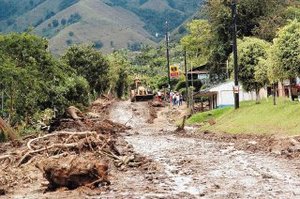
|
| ©La Nacion |
| Communities of Perez Zeledon are just now regaining road access after Alma. |
The effects of tropical storm Alma, the first of the season, are still being felt in the southern zone of Costa Rica where a record amount of destruction occurred along the Interamerican Highway and many families are still without shelter after watching their properties get washed away in the floods. The storm provoked at least 34 landslides that obstructed or destroyed large segments of road trapping some 1,500 people for two days and cutting off the south of the country and access to Panama.
Alma, which is the first tropical depression ever to be born in Costa Rican territory, is said to have caused more damage than hurricanes in the past, including Hurricane Cesar that passed through in 1996 destroying sectors of the same road. More than 8,000 people were left without drinking water or electricity, and the flooding caused nearly $40 million in damages.
How did this occur? In the past, hurricanes have affected the country indirectly because they were relatively close, but never before was a storm ever born in our waters. Low pressure and a heavy accumulation of clouds, with rain and lightning that somehow set off differently than was expected and high ocean temperatures helped in the formation of the storm. When the cloud formation hit the warm water, the speed of the wind increased dramatically, giving birth to what was categorized a tropical depression, soon becoming a tropical storm. This took place some 50 kms away from the coast of Guanacaste, something never ever seen before!
Juan Carlos Fallas, director of the National Meteorological Institute (IMN), said that this occurred this year because of the rainy activity along the Pacific coast, which usually occurs in the Caribbean. Meteorologists pointed out that this had occurred previously in Mexico, but that never before had this phenomenon occurred in our waters. The IMN reckons that during this period, we received between 50 and 80 millimeters more water than usual in some regions of the country, and this is going to surpass the average rainfall that we get normally during this season in these sectors. In the mountains, the precipitation could easily reach the 100 millimeters, and winds in the northern and central Pacific can be expected to reach 70 kms per hour.
Today the Ministry of Public Works and Transportation said it expects to take at least a month to fully restore and reopen the Interamerican Highway. The rain that continues to fall in the region is making it hard for workers to begin the process of rebuilding some of the sectors of road that washed away. Depending on the weekend's weather, MOPT hopes to open at least one lane of the road so that cars can pass by this coming Tuesday.
The worst damage to the road occurred along the so-called "Mountain of Death", 29 kilometers north of San Isidro de El General, known for treacherous turns, weather conditions and fog. Sections of the outer lane as long as 500 meters collapsed under the weight of the falling mud and debris as the supports beneath the road were also washed away. Engineers must identify which areas need to be stabilized with rock walls to allow for safe passage.



Reader Comments
to our Newsletter